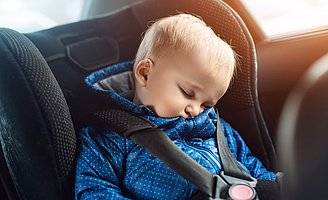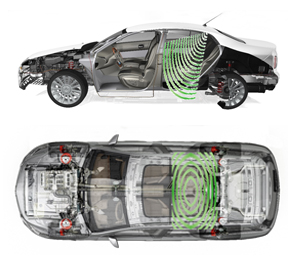Anonymous monitoring of the car interior
InCabin Radar Monitoring
Radar data contribute to passenger safety and protecting little ones.
InnoSenT’s product solution detects precisely how many people are in the vehicle interior and at which seat position they are located. Radar reliably recognises adults, little children, and animals. The system provides this information to the driver. For example, the system reminds the driver of further passengers in the back seats when the driver exits the vehicle. The function tackles the problem of children remaining in the car.
Radar technology aims to prevent life-threatening cases of heat stroke affecting children or animals through the use of an alarm. In addition, passenger detection is important in case of accident situations. Because every second counts here. In combination with an automatic emergency call system, it is possible to communicate radar information directly to the rescue workers. The emergency personnel already receive useful data about what seats are occupied by passengers in the vehicle.
According to InnoSenT’s information, this feature will be a relevant criterion for the awarding of the Euro NCAP stars assessing vehicle safety starting in 2024.
At a glance
The in-cabin radar system from InnoSenT enables reliable child presence and seat occupancy detection. It records living beings inside the car anonymously and without contact. Among other things, the sensor system warns of passengers left inside when the user gets out of the vehicle. The function can also be combined with safety measures such as belt tightening and monitoring.
Contrary to previous solutions often integrated in the seat detecting only seat occupancy, the product also records passengers’ breathing movements. This presents the possibility of intelligent and automated protective functions and offers much better performance.
The radar system measures parameters such as distance, movement, speed, direction of movement and angular position.
Product features
60 GHz MIMO Radar (FMCW)
detection of breathing movements
reliable detection of people or animals inside the vehicle
millimetre-precise motion measurement
high integration level and light, mechanical installation
compact, flat dimensions and low weight
no maintenance required
monitors entire row of seats and the car’s footwell

Radar technology brings in-cabin monitoring to the next level.
The special feature: detection of breathing.
The electromagnetic waves also detect the slightest movements. Patterns such as the rising and falling of a person’s chest can be determined this way. The radar system perceives even minimal and slow changes. Breathing can thus be detected even under warm winter clothes or blankets, since the technology differentiates movement even in the millimetre range. This is an important safety measure which helps with providing quick assistance to children inside the vehicle, in particular, in hazardous situations.
The Functionality

How does in-cabin monitoring work?
The function starts as desired by the automotive manufacturer. An example of this is the system being activated as soon as the vehicle doors are locked. The radar system monitors the interior and checks whether there are still living beings inside.
In comparison to alternative technological approaches, radar offers decisive advantages: the system can be integrated behind a cover due to its compact design and the properties of electromagnetic waves. The detection principle does not require any direct contact and is anonymous. Radar impresses with precision, regardless of temperature or lighting conditions.
Its extensive data collection regarding direction of movement, speed, distance, and angle offset provides a very detailed basis for reliably detecting occupants. Because it is only through the precise analysis of radar information that the system is able to differentiate between people and objects. It analyses the movements inside the vehicle and compares this with known patterns in order to filter out interfering factors on the back seats.
The sensor is generally positioned such that it focuses on the rear seats and also monitors the footwell of the car. It is generally integrated invisibly into the roof liner. If the radar waves detect a person or animal, the system transmits this information and triggers a warning mechanism for the vehicle if necessary. Depending on the vehicle manufacturer and configuration, this may include activating the hazard warning lights, loud honking, or even an eCall to the emergency rescue service.
Innovative technology for sensitive and precise measurements
For interior monitoring, InnoSenT has developed an FMCW radar with high measurement accuracy. Due to its detailed motion detection in the millimetre range, the system is also classified as a micro-Doppler radar. To attain this precision, the radar experts rely on a high-frequency approach. This high resolution is achieved through the arrangement of several transmitting and receiving antennas as well as a high bandwidth. In an instant, the system determines all relevant information, uses intelligent algorithms to take a decision regarding the situation, and further processes the signal.
The challenge of in-cabin monitoring is to limit detection to the vehicle interior. People within the proximity of the car must not cause erroneous detections. InnoSenT resolves this issue by precisely locating occupants using additional angle and distance information.
In the development, the radar experts also focused on producing a product that is as easy to install as possible. The dimensions are flat in order to be suitable for special vehicle models with panoramic roofs. This way, car manufacturers do not have to adapt the hardware to a new body every time. No field maintenance is required either.
In-cabin monitoring is a completely new approach that will prove useful to many applications in the future. In particular for autonomous driving, the technology boasts interesting further developments regarding the analysis of passengers’ vital parameters.






